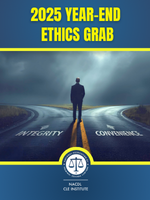Access to The Champion archive is one of many exclusive member benefits. It’s normally restricted to just NACDL members. However, this content, and others like it, is available to everyone in order to educate the public on why criminal justice reform is a necessity.
Author’s Note:I originally posted this column Feb. 12, 2018, on Medium (medium.com), the publishing platform created by the founders of Twitter. I sincerely hope that the CJA Study will have been released by the time this edition of The Champion is in the hands of readers so that there can be a robust discussion about the recommendations. If it has not been released, I urge all interested parties to write to the Administrative Office of the Courts, to the attention of Director James C. Duff (1 Columbus Circle NE, Washington, DC 20544) to request the prompt release of the report.
The recent federal budget deal effectively ended an era of constricted federal spending known as “sequestration.” When sequestration was first imposed, it exposed serious flaws that existed in the infrastructure of the nation’s federal public defense system. Since 1964, the Criminal Justice Act (CJA) has been the primary legislation providing for the Sixth Amendment right to counsel for those accused of federal crimes. The legislation provides funding for the appointment and compensation of counsel and payment of experts, investigators, and other supports necessary to defense services for those unable to afford counsel. Severe cuts to the CJA budget threatened the viability of the federal public defense system, which had been one of the few bright spots in what otherwise has widely been recognized as national neglect of public defense throughout the states.
NACDL was one major national organization to use this moment to initiate a close look at the overall structure and functioning of the system. Beginning in late 2013, NACDL established a Federal Indigent Task Force to conduct a focused review of federal public defense. Over the following year, NACDL’s task force conducted more than 130 interviews with key stakeholders, including representatives of the Administrative Office of the U.S. Courts,1 which has responsibility for oversight of the CJA program.2 NACDL identified significant, persistent deficiencies in the system, many of which were deeply rooted and festered long before sequestration. As a result of that study, in 2015 NACDL issued a comprehensive report and a series of recommendations to reform the system. Federal Indigent Defense 2015: The Independence Imperative3 documented pervasive problems in the system, many of which arose from undue judicial influence, inadequate funding, interference with the independence of the defense function, and a pervasive lack of transparency. Among other recommendations, NACDL called for a thorough review of the federal indigent defense system, something which had not occurred for more than two decades.
On the eve of the publication of NACDL’s findings, U.S. Supreme Court Chief Justice John G. Roberts, Jr. announced the creation of the Committee to Review the Criminal Justice Act Program (Review Committee). The Committee was to undertake “a comprehensive review of the operation and administration of the Criminal Justice Act,” assess its strengths and weaknesses, and make recommendations for its improvement. NACDL welcomed this development. While NACDL’s investigation was thorough, it was largely accomplished by volunteer attorneys operating with minimal resources. The Committee, created at the direction of the Judicial Conference of the United States and operating with a major commitment of resources by the Administrative Office of the Courts, would be able to engage in a comprehensive study and assessment of every aspect of the program. And that is precisely what happened.
The Chief Justice appointed the Hon. Kathleen Cardone, U.S. District Judge for the Western District of Texas, to chair the committee, and appointed an array of distinguished judges, a circuit executive, an academic, a former U.S. attorney, and representatives of the federal defenders and the CJA panel attorneys to serve on the committee. James Duff, Director of the Administrative Office, assigned 14 issues for the Committee to examine. Committee members were given ample staff support and significant financial resources to undertake their nationwide study.
Beginning in 2015, the CJA Review Committee conducted extensive multiday public hearings in seven cities: Santa Fe, New Mexico; Miami, Florida; Portland, Oregon; Birmingham, Alabama; San Francisco, California; Philadelphia, Pennsylvania; and Minneapolis, Minnesota. Based upon the publicly available agendas and record4 of the proceedings, it is no exaggeration to state that hundreds of witnesses testified and submitted written statements. Every stakeholder in the criminal justice system and other interested parties were afforded an opportunity to provide input to the Review Committee. Among them was NACDL’s then-President E. G. “Gerry” Morris, who testified at the Santa Fe hearing and later submitted additional comments. An enormous commitment of time, effort, and public resources were devoted to this project.
So what did the Committee find? What are its recommendations? What is the state of the federal public defense system? And where do we go to from here? That is the mystery.
According to the CJA Review Committee website,5 the report was submitted to A.O. Director Duff on Nov. 2, 2017. Now, three and a half months later, the report remains unavailable to the public. For a brief period of time, there was a statement on the website that the report was “available.” But there was no link, no contact information for anyone to request the report, and no other explanation of exactly what “available” meant. In short order, this statement was deleted from the website. Today the website remains silent as to when or even whether the report will be made available to the public.
One of the most persistent critiques of the judiciary’s control of the nation’s federal public defense system has been lack of transparency. After having engaged concerned stakeholders and the public in a process that appeared to be thorough and exhaustive, there is no excuse for the delay in making the findings of the CJA Study Committee public. Whether any constituency, including the Administrative Office of the Courts or the federal judiciary itself, agrees with the report and recommendations is irrelevant. The public has a right to see what the Committee found. The immediate public release of this exhaustive and costly study would be an important, tangible step to address the concerns about a lack of transparency. The continued delay of its public release only underscores that those concerns were indeed well-founded.
Notes
- The Administrative Office serves the federal courts, providing legislative, legal, financial, technical, administrative, and programmatic support. “A primary responsibility of the Administrative Office is to provide staff support and counsel to the Judicial Conference and its committees.” http://www.uscourts.gov/about-federal-courts/judicial-administration (last visited Feb. 12, 2018).
- “Acting under the supervision and direction of the Judicial Conference, the Administrative Office of the United States Courts oversees the expenditure of funds appropriated by Congress; administers the federal defender and panel attorney program on a national basis; is responsible for training related to furnishing representation under the CJA; and provides legal, policy, management, and fiscal advice to the Conference and its committees, judges, defenders and their staffs, and panel attorneys. Program support for the CJA is provided by the Defender Services Office of the Administrative Office of the United States Courts, Department of Program Services.” http://www.uscourts.gov/services-forms/defender-services (last visited Feb. 12, 2018).
- https://www.nacdl.org/federalindigentdefense2015.
- http://cjastudy.fd.org/public-hearings.
- https://cjastudy.fd.org.
About the Author
Norman L. Reimer is NACDL’s Executive Director and Publisher of The Champion.
Norman L. Reimer
NACDL
Washington, DC
202-465-7623
www.nacdl.org
@NACDL
nreimer@nacdl.org













